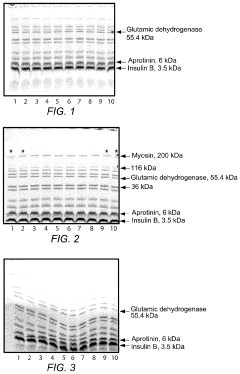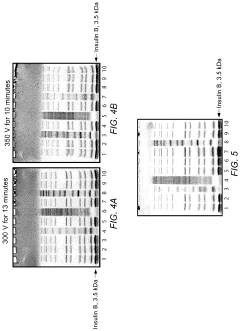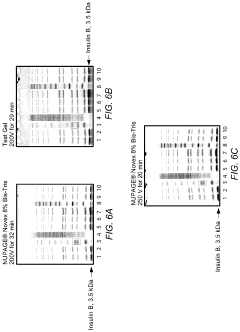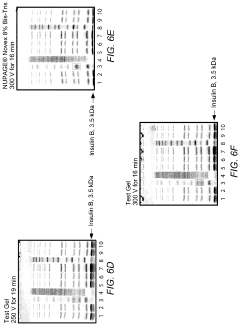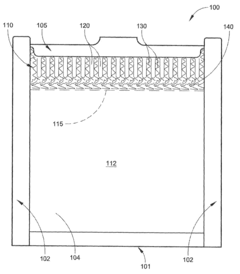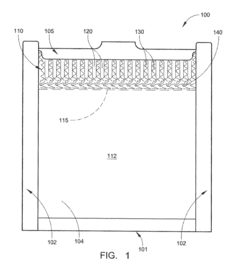How to Enhance Band Visibility in Gel Electrophoresis?
JUN 30, 20259 MIN READ
Generate Your Research Report Instantly with AI Agent
Patsnap Eureka helps you evaluate technical feasibility & market potential.
Gel Electrophoresis Background and Objectives
Gel electrophoresis is a fundamental technique in molecular biology, widely used for separating and analyzing DNA, RNA, and proteins based on their size and charge. This method has been a cornerstone of genetic research and diagnostics since its development in the 1960s. The technique involves applying an electric field to move charged molecules through a gel matrix, typically agarose or polyacrylamide, resulting in the separation of these molecules into distinct bands.
The primary objective of enhancing band visibility in gel electrophoresis is to improve the detection and analysis of biomolecules, particularly in situations where sample concentrations are low or when dealing with complex mixtures. Increased visibility allows for more accurate quantification, better resolution of closely spaced bands, and the ability to detect minor components in a sample. This enhancement is crucial for various applications, including DNA fingerprinting, genetic disorder diagnosis, and protein characterization.
Over the years, the field of gel electrophoresis has seen significant advancements, driven by the need for higher sensitivity and resolution. Early methods relied on simple staining techniques, such as ethidium bromide, which, while effective, had limitations in terms of sensitivity and safety. The evolution of this technology has led to the development of more sensitive fluorescent dyes, advanced imaging systems, and novel gel formulations.
The current technological landscape presents several challenges and opportunities for improving band visibility. These include developing safer and more sensitive staining methods, enhancing the optical properties of gels, and improving imaging and analysis software. Additionally, there is a growing interest in real-time visualization techniques that allow for monitoring of the separation process as it occurs.
As we look towards the future, the goals for enhancing band visibility in gel electrophoresis are multifaceted. They include increasing the detection limit to allow for analysis of trace amounts of biomolecules, improving the dynamic range to enable simultaneous visualization of high and low abundance species, and developing methods that are more environmentally friendly and cost-effective. There is also a push towards integrating gel electrophoresis with other analytical techniques to create more comprehensive and powerful analytical platforms.
In conclusion, the background and objectives of enhancing band visibility in gel electrophoresis reflect a continuous drive towards more sensitive, accurate, and versatile analytical methods. This ongoing evolution is essential for advancing our understanding of molecular biology and for developing more powerful diagnostic and research tools.
The primary objective of enhancing band visibility in gel electrophoresis is to improve the detection and analysis of biomolecules, particularly in situations where sample concentrations are low or when dealing with complex mixtures. Increased visibility allows for more accurate quantification, better resolution of closely spaced bands, and the ability to detect minor components in a sample. This enhancement is crucial for various applications, including DNA fingerprinting, genetic disorder diagnosis, and protein characterization.
Over the years, the field of gel electrophoresis has seen significant advancements, driven by the need for higher sensitivity and resolution. Early methods relied on simple staining techniques, such as ethidium bromide, which, while effective, had limitations in terms of sensitivity and safety. The evolution of this technology has led to the development of more sensitive fluorescent dyes, advanced imaging systems, and novel gel formulations.
The current technological landscape presents several challenges and opportunities for improving band visibility. These include developing safer and more sensitive staining methods, enhancing the optical properties of gels, and improving imaging and analysis software. Additionally, there is a growing interest in real-time visualization techniques that allow for monitoring of the separation process as it occurs.
As we look towards the future, the goals for enhancing band visibility in gel electrophoresis are multifaceted. They include increasing the detection limit to allow for analysis of trace amounts of biomolecules, improving the dynamic range to enable simultaneous visualization of high and low abundance species, and developing methods that are more environmentally friendly and cost-effective. There is also a push towards integrating gel electrophoresis with other analytical techniques to create more comprehensive and powerful analytical platforms.
In conclusion, the background and objectives of enhancing band visibility in gel electrophoresis reflect a continuous drive towards more sensitive, accurate, and versatile analytical methods. This ongoing evolution is essential for advancing our understanding of molecular biology and for developing more powerful diagnostic and research tools.
Market Analysis for Enhanced Gel Imaging Solutions
The market for enhanced gel imaging solutions in electrophoresis is experiencing significant growth, driven by the increasing demand for more sensitive and accurate band detection methods. This market segment is closely tied to the broader life sciences and biotechnology industries, which are projected to expand at a robust pace in the coming years.
The primary drivers of this market include the growing emphasis on precision medicine, advancements in genomics and proteomics research, and the rising need for high-throughput screening in drug discovery processes. As researchers and laboratories seek to improve the visibility and resolution of DNA and protein bands in gel electrophoresis, there is a clear opportunity for innovative imaging solutions.
Currently, the global market for gel documentation systems, which includes enhanced imaging solutions, is valued in the billions of dollars. The market is expected to grow steadily, with a compound annual growth rate (CAGR) in the mid-single digits over the next five years. This growth is attributed to the increasing adoption of digital imaging systems and the integration of advanced software for image analysis and data interpretation.
Geographically, North America holds the largest market share, followed by Europe and Asia-Pacific. The Asia-Pacific region, particularly China and India, is anticipated to witness the fastest growth due to increasing investment in life sciences research and the expansion of biotechnology industries in these countries.
Key market segments within enhanced gel imaging solutions include UV transilluminators, LED-based systems, laser-excited fluorescence imagers, and chemiluminescence detectors. Among these, LED-based systems are gaining traction due to their safety, cost-effectiveness, and ability to work with a wide range of fluorescent dyes.
The market is characterized by a mix of established players and innovative start-ups. Major companies in this space are continuously investing in research and development to improve their product offerings and maintain their competitive edge. Collaborations between academic institutions and industry players are also driving innovation in this field.
Customer segments for enhanced gel imaging solutions include academic and research institutions, pharmaceutical and biotechnology companies, forensic laboratories, and clinical diagnostic centers. Each segment has specific requirements, ranging from high-throughput capabilities for large-scale genomic studies to portable solutions for point-of-care diagnostics.
As the demand for more sensitive and accurate band detection in gel electrophoresis continues to grow, there is a clear market opportunity for solutions that can enhance band visibility. Companies that can develop innovative, cost-effective, and user-friendly imaging technologies are likely to capture significant market share in this expanding field.
The primary drivers of this market include the growing emphasis on precision medicine, advancements in genomics and proteomics research, and the rising need for high-throughput screening in drug discovery processes. As researchers and laboratories seek to improve the visibility and resolution of DNA and protein bands in gel electrophoresis, there is a clear opportunity for innovative imaging solutions.
Currently, the global market for gel documentation systems, which includes enhanced imaging solutions, is valued in the billions of dollars. The market is expected to grow steadily, with a compound annual growth rate (CAGR) in the mid-single digits over the next five years. This growth is attributed to the increasing adoption of digital imaging systems and the integration of advanced software for image analysis and data interpretation.
Geographically, North America holds the largest market share, followed by Europe and Asia-Pacific. The Asia-Pacific region, particularly China and India, is anticipated to witness the fastest growth due to increasing investment in life sciences research and the expansion of biotechnology industries in these countries.
Key market segments within enhanced gel imaging solutions include UV transilluminators, LED-based systems, laser-excited fluorescence imagers, and chemiluminescence detectors. Among these, LED-based systems are gaining traction due to their safety, cost-effectiveness, and ability to work with a wide range of fluorescent dyes.
The market is characterized by a mix of established players and innovative start-ups. Major companies in this space are continuously investing in research and development to improve their product offerings and maintain their competitive edge. Collaborations between academic institutions and industry players are also driving innovation in this field.
Customer segments for enhanced gel imaging solutions include academic and research institutions, pharmaceutical and biotechnology companies, forensic laboratories, and clinical diagnostic centers. Each segment has specific requirements, ranging from high-throughput capabilities for large-scale genomic studies to portable solutions for point-of-care diagnostics.
As the demand for more sensitive and accurate band detection in gel electrophoresis continues to grow, there is a clear market opportunity for solutions that can enhance band visibility. Companies that can develop innovative, cost-effective, and user-friendly imaging technologies are likely to capture significant market share in this expanding field.
Current Challenges in Band Visibility
Gel electrophoresis is a fundamental technique in molecular biology, yet it faces several challenges in achieving optimal band visibility. One of the primary issues is the sensitivity of detection, particularly for low-abundance DNA or protein samples. Traditional staining methods often struggle to visualize faint bands, leading to potential data loss or misinterpretation of results.
Another significant challenge is the background noise that can obscure band clarity. Factors such as impurities in the gel matrix, non-specific binding of stains, or autofluorescence can contribute to high background signals, making it difficult to distinguish genuine bands from artifacts. This problem is especially pronounced when working with complex biological samples or when attempting to detect minor DNA or protein variants.
The resolution of closely spaced bands presents a further obstacle in gel electrophoresis. As molecular biology techniques become more sophisticated, there is an increasing need to differentiate between fragments with minimal size differences. Current gel systems and imaging technologies may not always provide the necessary resolution, particularly for larger molecules or in cases where multiple bands are clustered together.
Consistency and reproducibility in band visibility also pose challenges. Variations in gel preparation, running conditions, and staining procedures can lead to inconsistent results between experiments or laboratories. This variability complicates data interpretation and hinders the comparison of results across different studies or time points.
The time-consuming nature of achieving optimal band visibility is another hurdle. Many current protocols require lengthy staining and destaining steps, which not only extend the overall experimental time but also increase the risk of band diffusion, potentially compromising the accuracy of size estimation and quantification.
Environmental and safety concerns associated with traditional staining methods, such as the use of ethidium bromide, have led to a search for safer alternatives. However, these alternatives often come with trade-offs in terms of sensitivity or ease of use, presenting researchers with difficult choices between safety and performance.
Lastly, the quantification of band intensity remains a challenge, particularly when dealing with a wide dynamic range of sample concentrations. Current imaging systems and analysis software may struggle to accurately quantify very faint or overly intense bands, limiting the ability to perform precise comparative analyses.
Addressing these challenges in band visibility is crucial for advancing the reliability and applicability of gel electrophoresis across various fields of biological research. Innovations in gel composition, staining techniques, and imaging technologies are needed to overcome these limitations and enhance the power of this essential analytical tool.
Another significant challenge is the background noise that can obscure band clarity. Factors such as impurities in the gel matrix, non-specific binding of stains, or autofluorescence can contribute to high background signals, making it difficult to distinguish genuine bands from artifacts. This problem is especially pronounced when working with complex biological samples or when attempting to detect minor DNA or protein variants.
The resolution of closely spaced bands presents a further obstacle in gel electrophoresis. As molecular biology techniques become more sophisticated, there is an increasing need to differentiate between fragments with minimal size differences. Current gel systems and imaging technologies may not always provide the necessary resolution, particularly for larger molecules or in cases where multiple bands are clustered together.
Consistency and reproducibility in band visibility also pose challenges. Variations in gel preparation, running conditions, and staining procedures can lead to inconsistent results between experiments or laboratories. This variability complicates data interpretation and hinders the comparison of results across different studies or time points.
The time-consuming nature of achieving optimal band visibility is another hurdle. Many current protocols require lengthy staining and destaining steps, which not only extend the overall experimental time but also increase the risk of band diffusion, potentially compromising the accuracy of size estimation and quantification.
Environmental and safety concerns associated with traditional staining methods, such as the use of ethidium bromide, have led to a search for safer alternatives. However, these alternatives often come with trade-offs in terms of sensitivity or ease of use, presenting researchers with difficult choices between safety and performance.
Lastly, the quantification of band intensity remains a challenge, particularly when dealing with a wide dynamic range of sample concentrations. Current imaging systems and analysis software may struggle to accurately quantify very faint or overly intense bands, limiting the ability to perform precise comparative analyses.
Addressing these challenges in band visibility is crucial for advancing the reliability and applicability of gel electrophoresis across various fields of biological research. Innovations in gel composition, staining techniques, and imaging technologies are needed to overcome these limitations and enhance the power of this essential analytical tool.
Existing Methods for Band Enhancement
01 Optimization of gel composition
Improving band visibility in gel electrophoresis can be achieved by optimizing the gel composition. This includes adjusting the concentration of agarose or polyacrylamide, as well as incorporating additives that enhance the separation and visualization of DNA or protein bands. Proper gel composition can lead to sharper, more distinct bands and improved overall resolution.- Optimization of gel composition: The visibility of bands in gel electrophoresis can be improved by optimizing the gel composition. This includes adjusting the concentration of agarose or polyacrylamide, as well as incorporating additives that enhance band resolution and clarity. Proper gel composition can lead to sharper and more distinct bands, making them easier to visualize and analyze.
- Enhanced staining techniques: Improved staining methods can significantly enhance band visibility in gel electrophoresis. This includes the use of fluorescent dyes, silver staining, or other sensitive staining techniques that can detect even low concentrations of DNA or proteins. Advanced staining protocols can increase the contrast between bands and the background, making them more visible and easier to interpret.
- Optimization of electrophoresis conditions: Adjusting electrophoresis conditions such as voltage, current, and run time can improve band visibility. Proper optimization of these parameters can lead to better separation of molecules, resulting in clearer and more distinct bands. This includes techniques like pulsed-field gel electrophoresis for separating larger DNA fragments.
- Use of specialized imaging systems: Advanced imaging systems and software can enhance the visibility of gel electrophoresis bands. These may include high-resolution cameras, UV or blue light transilluminators, and image analysis software that can adjust contrast, brightness, and other parameters to make bands more visible and easier to analyze.
- Sample preparation and loading techniques: Proper sample preparation and loading techniques can significantly improve band visibility. This includes methods for concentrating samples, removing impurities, and ensuring even loading across wells. Techniques such as sample stacking or the use of loading buffers can help concentrate samples into tight bands, improving overall visibility.
02 Enhanced staining techniques
Utilizing advanced staining techniques can significantly improve band visibility. This may involve the use of fluorescent dyes, silver staining, or other sensitive detection methods. These techniques can increase the contrast between the bands and the background, making even faint bands more visible and easier to analyze.Expand Specific Solutions03 Improved buffer systems
The choice of buffer system plays a crucial role in band visibility. Optimizing the buffer composition, pH, and ionic strength can enhance the separation of molecules and improve band sharpness. Specialized buffer systems can be developed for specific applications to maximize band visibility and resolution.Expand Specific Solutions04 Advanced imaging and detection systems
Implementing state-of-the-art imaging and detection systems can greatly enhance the visibility of electrophoresis bands. This may include high-resolution digital cameras, specialized light sources, and image analysis software. These advanced systems can detect and visualize even faint bands that might be missed by conventional methods.Expand Specific Solutions05 Sample preparation and loading techniques
Improving sample preparation and loading techniques can lead to better band visibility. This includes optimizing sample concentration, reducing contaminants, and using specialized loading buffers. Proper sample preparation and loading can result in cleaner, more distinct bands and reduce background noise in the gel.Expand Specific Solutions
Key Players in Gel Electrophoresis Industry
The gel electrophoresis market is in a mature stage, with a global size estimated at over $1 billion. The technology is well-established and widely used in research and clinical applications. Key players like Life Technologies, Bio-Rad Laboratories, and Applied Biosystems dominate the market with advanced products. However, there is ongoing innovation in areas like high-resolution imaging and automated systems. Emerging companies like Expedeon and Changzhou Smart Lifesciences are introducing novel reagents and techniques to enhance band visibility and separation. Academic institutions like Shanghai Jiao Tong University and Brandeis University continue to contribute fundamental research to improve the technology.
Life Technologies Corp.
Technical Solution: Life Technologies Corp. has developed advanced fluorescent dye technologies to enhance band visibility in gel electrophoresis. Their SYBR Safe DNA gel stain offers improved sensitivity and reduced background compared to traditional ethidium bromide[1]. They have also introduced the Invitrogen E-Gel Power Snap Electrophoresis System, which combines pre-cast agarose gels with a compact, all-in-one device for rapid, high-resolution DNA separation and visualization[2]. This system incorporates LED illumination and real-time band tracking, allowing researchers to monitor DNA migration during electrophoresis and capture images at optimal separation points[3].
Strengths: High sensitivity, reduced background noise, and improved safety. Weaknesses: May require specialized equipment and higher initial costs.
Bio-Rad Laboratories, Inc.
Technical Solution: Bio-Rad Laboratories has developed the Clarity Western ECL Substrate, a highly sensitive chemiluminescent detection system for Western blotting that enhances band visibility in gel electrophoresis[4]. Their Stain-Free technology allows for instant visualization of proteins in gels and on membranes without the need for staining steps, significantly reducing time and improving consistency[5]. Additionally, Bio-Rad's Image Lab software provides advanced analysis tools for quantification and normalization of electrophoresis results, enhancing the overall visibility and interpretation of bands[6].
Strengths: Time-saving technologies, high sensitivity, and advanced analysis tools. Weaknesses: May require specific Bio-Rad equipment for optimal performance.
Innovative Approaches to Improve Band Visibility
System for rapid high-resolution GEL electrophoresis
PatentActiveUS20190391113A1
Innovation
- The development of electrophoretic systems and formulations that allow for higher field strengths up to 50% more than conventional systems, using a discontinuous buffer system with specific gel amine and ampholyte buffers, and a pH range of 5.5 to 7.5, enabling faster separation of proteins within 30 minutes or less, even at higher voltages.
Electrophoresis Gel and Method of Making Same
PatentInactiveUS20100236932A1
Innovation
- Incorporating insoluble pigmented materials into the loading area of the electrophoresis gel, such as dry powder-coat paint or colored plastic beads, to create a visually distinct area that is easy to see, without interfering with the electrophoretic separation.
Safety and Environmental Considerations
Gel electrophoresis is a widely used technique in molecular biology laboratories, and while it offers significant benefits for research and analysis, it also presents several safety and environmental considerations that must be addressed. The primary concern revolves around the use of potentially hazardous chemicals and materials throughout the process.
One of the most critical safety issues is the handling of ethidium bromide, a common DNA staining agent. This compound is highly mutagenic and potentially carcinogenic, requiring careful handling and disposal procedures. Laboratories are increasingly adopting safer alternatives, such as SYBR Safe or GelRed, which offer reduced toxicity while maintaining effective DNA visualization.
The use of ultraviolet (UV) light for band visualization poses another safety risk. Prolonged exposure to UV radiation can cause skin and eye damage. To mitigate this, researchers should always wear appropriate personal protective equipment, including UV-resistant face shields and gloves. Some labs are transitioning to blue-light transilluminators, which offer a safer alternative without compromising band visibility.
Environmental considerations in gel electrophoresis primarily focus on the proper disposal of gels and buffers. Agarose and polyacrylamide gels, along with their associated buffers, may contain harmful chemicals that should not be released into the environment. Implementing proper waste segregation and disposal protocols is essential to minimize environmental impact.
The use of plastic consumables in gel electrophoresis also contributes to laboratory waste. Adopting reusable gel trays and combs, where possible, can help reduce plastic waste. Additionally, some laboratories are exploring biodegradable alternatives for gel matrices, which could significantly decrease the environmental footprint of this technique.
Power consumption is another environmental factor to consider. Optimizing run times and using energy-efficient power supplies can help reduce the overall energy consumption associated with gel electrophoresis experiments. Some modern electrophoresis systems incorporate energy-saving features, such as automatic shut-off mechanisms.
To enhance band visibility while maintaining safety and environmental responsibility, researchers can explore newer, safer staining methods and visualization techniques. For instance, pre-cast gels with integrated safe stains are becoming more popular, reducing exposure to harmful chemicals. Additionally, digital imaging systems that require lower light intensity for visualization can improve both safety and image quality.
In conclusion, addressing safety and environmental considerations in gel electrophoresis is crucial for responsible laboratory practices. By adopting safer alternatives, implementing proper waste management, and considering energy efficiency, researchers can enhance band visibility while minimizing risks to personnel and the environment.
One of the most critical safety issues is the handling of ethidium bromide, a common DNA staining agent. This compound is highly mutagenic and potentially carcinogenic, requiring careful handling and disposal procedures. Laboratories are increasingly adopting safer alternatives, such as SYBR Safe or GelRed, which offer reduced toxicity while maintaining effective DNA visualization.
The use of ultraviolet (UV) light for band visualization poses another safety risk. Prolonged exposure to UV radiation can cause skin and eye damage. To mitigate this, researchers should always wear appropriate personal protective equipment, including UV-resistant face shields and gloves. Some labs are transitioning to blue-light transilluminators, which offer a safer alternative without compromising band visibility.
Environmental considerations in gel electrophoresis primarily focus on the proper disposal of gels and buffers. Agarose and polyacrylamide gels, along with their associated buffers, may contain harmful chemicals that should not be released into the environment. Implementing proper waste segregation and disposal protocols is essential to minimize environmental impact.
The use of plastic consumables in gel electrophoresis also contributes to laboratory waste. Adopting reusable gel trays and combs, where possible, can help reduce plastic waste. Additionally, some laboratories are exploring biodegradable alternatives for gel matrices, which could significantly decrease the environmental footprint of this technique.
Power consumption is another environmental factor to consider. Optimizing run times and using energy-efficient power supplies can help reduce the overall energy consumption associated with gel electrophoresis experiments. Some modern electrophoresis systems incorporate energy-saving features, such as automatic shut-off mechanisms.
To enhance band visibility while maintaining safety and environmental responsibility, researchers can explore newer, safer staining methods and visualization techniques. For instance, pre-cast gels with integrated safe stains are becoming more popular, reducing exposure to harmful chemicals. Additionally, digital imaging systems that require lower light intensity for visualization can improve both safety and image quality.
In conclusion, addressing safety and environmental considerations in gel electrophoresis is crucial for responsible laboratory practices. By adopting safer alternatives, implementing proper waste management, and considering energy efficiency, researchers can enhance band visibility while minimizing risks to personnel and the environment.
Automation and Digital Integration in Gel Analysis
The integration of automation and digital technologies in gel electrophoresis analysis has revolutionized the field, significantly enhancing band visibility and overall data quality. Modern gel documentation systems now incorporate advanced imaging technologies, such as high-resolution CCD cameras and LED illumination, which capture gel images with unprecedented clarity and sensitivity. These systems often feature automatic exposure optimization and dynamic range adjustment, ensuring that even faint bands are detected without overexposing stronger signals.
Digital image analysis software has become an integral part of gel electrophoresis workflows. These programs offer sophisticated algorithms for band detection, quantification, and normalization. They can automatically identify lanes, detect bands, and measure their intensity, reducing human error and increasing reproducibility. Many software packages also provide tools for background subtraction and noise reduction, further improving band visibility and data accuracy.
Machine learning and artificial intelligence are increasingly being applied to gel analysis. These technologies can learn from large datasets to improve band detection accuracy, especially in complex or noisy gels. They can also assist in pattern recognition, helping researchers identify subtle differences between samples or experimental conditions that might be missed by human observers.
Automation extends beyond image capture and analysis to the entire electrophoresis process. Robotic systems can now handle sample loading, gel running, and even staining and destaining steps. This not only improves consistency and reduces human error but also allows for higher throughput and standardization of protocols across laboratories.
Cloud-based platforms for gel analysis are gaining popularity, enabling researchers to store, analyze, and share their gel data securely. These platforms often provide powerful computational resources for complex analyses and facilitate collaboration between research teams. They also ensure data integrity and traceability, which is crucial for regulatory compliance in many fields.
The integration of gel analysis with other laboratory information management systems (LIMS) and electronic lab notebooks (ELNs) streamlines data management and enhances overall research efficiency. This integration allows for seamless tracking of samples from preparation through analysis and reporting, reducing the risk of data loss or mix-ups.
As automation and digital integration continue to advance, we can expect further improvements in band visibility and data quality in gel electrophoresis. Future developments may include real-time analysis during gel runs, more sophisticated AI-driven interpretation of results, and integration with other analytical techniques for comprehensive sample characterization.
Digital image analysis software has become an integral part of gel electrophoresis workflows. These programs offer sophisticated algorithms for band detection, quantification, and normalization. They can automatically identify lanes, detect bands, and measure their intensity, reducing human error and increasing reproducibility. Many software packages also provide tools for background subtraction and noise reduction, further improving band visibility and data accuracy.
Machine learning and artificial intelligence are increasingly being applied to gel analysis. These technologies can learn from large datasets to improve band detection accuracy, especially in complex or noisy gels. They can also assist in pattern recognition, helping researchers identify subtle differences between samples or experimental conditions that might be missed by human observers.
Automation extends beyond image capture and analysis to the entire electrophoresis process. Robotic systems can now handle sample loading, gel running, and even staining and destaining steps. This not only improves consistency and reduces human error but also allows for higher throughput and standardization of protocols across laboratories.
Cloud-based platforms for gel analysis are gaining popularity, enabling researchers to store, analyze, and share their gel data securely. These platforms often provide powerful computational resources for complex analyses and facilitate collaboration between research teams. They also ensure data integrity and traceability, which is crucial for regulatory compliance in many fields.
The integration of gel analysis with other laboratory information management systems (LIMS) and electronic lab notebooks (ELNs) streamlines data management and enhances overall research efficiency. This integration allows for seamless tracking of samples from preparation through analysis and reporting, reducing the risk of data loss or mix-ups.
As automation and digital integration continue to advance, we can expect further improvements in band visibility and data quality in gel electrophoresis. Future developments may include real-time analysis during gel runs, more sophisticated AI-driven interpretation of results, and integration with other analytical techniques for comprehensive sample characterization.
Unlock deeper insights with Patsnap Eureka Quick Research — get a full tech report to explore trends and direct your research. Try now!
Generate Your Research Report Instantly with AI Agent
Supercharge your innovation with Patsnap Eureka AI Agent Platform!
